The morning started innocently enough. We awoke early to an absolutely fantastic sunrise:
We started schoolwork with the boys, but had guests motor over and give us an “Ahoy!”. It was Dick and Brenda from the motorboat ANNIE, a 34ft Diesel Duck design. Dick and Brenda are “mudskippers”; that is, they prefer to cruise coastal, in close. Their idea of a good thing is to motor up the coast about 1nm offshore at most. They say they like to see the countryside.
After a few cups of tea in the cockpit, discussing everything from Eskine Childers to the old iron mine that used to be on Redbill Pt. in West Arm, we felt the boat swing a little with the change to the ebb tide. A few more cups of tea later and the tide was seriously running out. Time to go to Georgetown and pick up the twenty-odd library books on hold for us there, before we missed the tide altogether.
Georgetown has four jetties. There’s the marina on the southern side of the bay, the yacht club facility on the northern side closest to Low Head, and further in, the two public jetties, close together.
There’s plenty of water alongside the public jetties, but apparently not a lot nearby…
My approach to the public jetty was largely dictated from our previous docking there… we had a strong southerly then and the outgoing tide; we tied up on the southwest facing jetty, bow into the wind. It worked well and made getting off easy, but the approach had been a bastard. We had to come in at right angles to the jetty, being blown sideways toward the shore only a few boat lengths away, and back and fill using the prop wash to turn us and tie up before the current swept us away. It was a tough manoeuvre and the bob stay rode up on the low jetty during the turn.
This time, I thought, I’d could approach at shallower angle with the northerly keeping me off the shore. I slowed our speed on approach, and noted the the outbound current was killing our speed a bit faster than usual, so I had to keep engaging and disengaging forward gear at idle to keep us going. Keeping an eye on our approach angle, skewing with the current, and having to drop my head and hand down to the gearbox controls at my feet meant I didn’t keep a eye on the depth sounder. Lis said “Mike, Look! The ground!” and the sounder went into alarm at 2 meters (we draw 1.5). I put the helm hard over for deeper water, but could feel her dragging, slowing down. A burst of throttle in forward didn’t help. Going hard in reverse didn’t clear us. Locked the helm over and leaving the engine revving hard in forward, we rushed to the starboard side and used our weight to heel us over… Did she move a little? Getting the boys on the side deck too, Lis and I coordinated our swing out, standing outboard of the shrouds. She heeled towards us and turned maybe a bit in the current, but then… nothing.
Time to do our “emergency launch” of the dinghy and get the second anchor out into deeper water to pull us off.
The “emergency launch” of the dinghy is something we’d practiced a few times for exactly this sort of occasion. Usually, we use the main boom and main sheet as a sort of boom crane to lower our expoxy/plywood 9’6″ Nutshell Pram into the water. It takes about 5 to 10 minutes. Instead, we lift her up inverted, Lis on the bow and me on the stern. On the count of three, we heave and flip her over the side and into the water with a splash. It takes about 30 seconds.
When we tossed her in this time, imagine our horror as a bloody horrible great split opened up on a planking seam, with one of her plywood planks torn across the breadth down through the fibreglass reinforcement too. I could clearly see daylight through the crack! With the falling tide, there was no time to dwell on this. I volunteered Lachie as bailer, got him into a life jacket and we got into the dinghy to row around to the bow to take the 35kg CQR anchor we use as a kedge, as it has rope rode.
Little aside here; If you have never tried to row an all chain rode anchor out to set in some distance from the mother ship, don’t bother. We have 3/8″ chain on our main anchor, and I can’t row more than 15ft away from the bow before the weight of chain leading back to the boat has me dead in the water. The only anchor you can take any distance away from your vessel is the one attached to floating rope rode.
So, off I rowed at a furious pace, Lachie bailing bucketful after bucketful out of the dinghy. To his credit, he was keeping up with the inflow, but we were ankle deep. 50m off in deeper water, I let the anchor go, and Lis immediately started hauling it in on the anchor whinch to set it and pull us off. I got back to the boat and rushed to the bow to help, but it was no use. By now we were starting to feel a bit bow down. The stern was hard aground and the water was running out from underneath us with the tide. The anchor rode was bar tight, and we weren’t going anywhere.
Lis noticed we were still heeled over to starboard, toward the deeper water. The heeling was getting more pronounced as the tide ran out. Quickly, I got a 100m reel of 10mm line out and made it fast to the main halyard while Lis (with Lachie on bailing duty again) rowed the dinghy around to the shore side (port) and took the reel ashore to a tree. Once she got the slack out and made it fast, I got the sheet onto the winch and started cranking on it to heel us over towards shore.
The danger we were in was this: When the water ran out, ERIK would heel over and careen on her bilges. If she heeled towards deep water, she would effectively be heeling over “downhill” and the final angle of rest would be much higher than it would be on flat ground. It might be so high that she would flood down hatch and vent before she refloated on the incoming tide… In which case she float free at all. That would be bad.
With the main halyard distantly tied to a tree pulling us over “uphill”, Lis came back for a mini-conference on what else, if anything, we could do. I decided to drag the uphill side of the bottom with a weight to see if there were any rocks we’d need to clear out before she settled over onto them. Lis went below and stoppered our portside vents and hatches. There was nothing more to do except wait for the tide, and by my estimate we had nearly four hours.
Lis and Lachie went ashore to the library. That left me and Alex aboard explaining to every passer-by how we’d ended up in this situation. After the first few times Alex got into the spirit of it, and I was happy to leave him to it. The local Georgetownians don’t get a lot of waterfront entertainment, I gather. We started collected quite a crowd ashore, with more arriving in one’s and two’s by car all the time. Running aground outside the pub probably had a lot to do with it… We even got a tour bus! I was less amused with the yobbo’s coming around in their speedboats to have a look at us, their wakes bounced us on the sand at one point, and they seemed to think my frantic arm waving was part of the show.
With all ashore things done, Lis came back and retrieved the masthead line, now we were resting on our side, we didn’t need it anymore. We loaded the dinghy onboard. Up close the split in her side was quite depressing. Not giving myself time to dwell on it, I left her do dry in the sun while I mentally went through how to repair her. We waited. And waited. The water level on various rocks ashore took on new meaning. Much looking at the time and tide tables. More waiting.
Eventually, the water returned. We slowly came upright, the bow slowly lifted. The kedge anchor rode was still bar tight, so as we lifted we kept a mark on shore, waiting for the bow to swing to the rode, free of the sand. When she did, we waited some more until the stern started dragging clear. Now was the time to move, we didn’t want to stay here long, bumping against the bottom. Gunning the engine we moved forward smartly,we were free!
Pulling the kedge anchor in is always a trial. Unlike chain, rope rode doesn’t flake itself into a nice tangle-free pile in the anchor locker. With Lis hauling in on the powered winch, I tailed the line and flaked it along the length of the side deck. We pulled up short on the rode and the bow dipped hard. The kedge was seriously stuck! We motored forward onto it, and the boat would push against the rode for a bit before spinning around it. Lis let out some slack and we drifted on the current, then, with the run up, we surged forward and tried to jerk the anchor out. It didn’t budge. Knowing in what direction it was set, we went around behind it, careful to keep the floating rode from fouling the propeller( wouldn’t that put the icing on the cake!). We swung around, reversed some slack into the rode, then gunned her forward again. This time we used the anchor winch as well, Lis taking in the slack as fast as she could. Again the bow dipped hard, but this time she bounced up with a jerk. Yay! The anchor was out!
I helmed as we motored back to West Arm, Lis down below flaking the rode back into its special part of the anchor locker. I spotted a boat ahead, making for the gap between the north end of Shag Rock and the shore. It would be a great little short cut to know, I thought, as I watched the yacht go through. The charts says there’s plenty of water in the narrow gap…. But no. Not today… Enough excitement had been had today. Later that evening we got the Sikaflex out and gunged up the split in the dinghies side. It’s ugly but it’s watertight, for the time being. I’m going to have to get to a 240v power outlet to do a proper stick-and-glue fix… But that’ll be a another blog post.
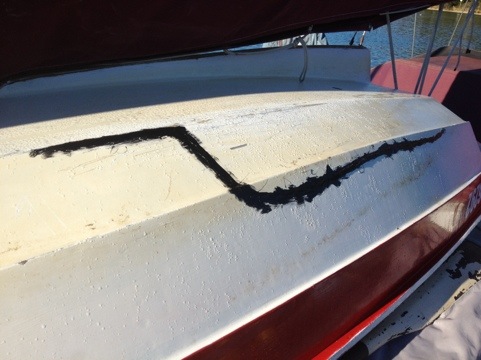
The split after liberal application of black icky sticky SikaFlex 291. Going to love sanding that crap out…


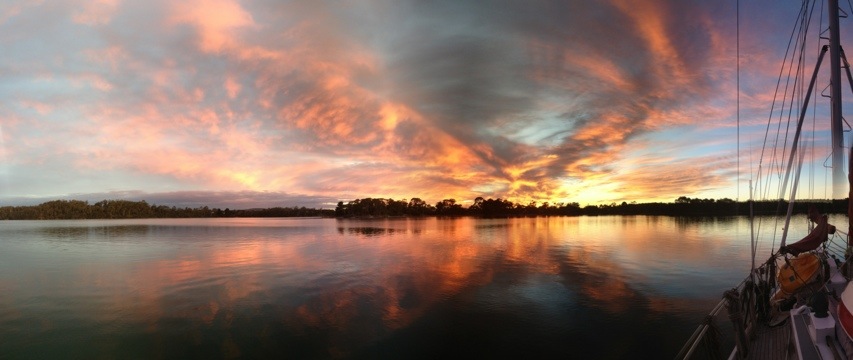
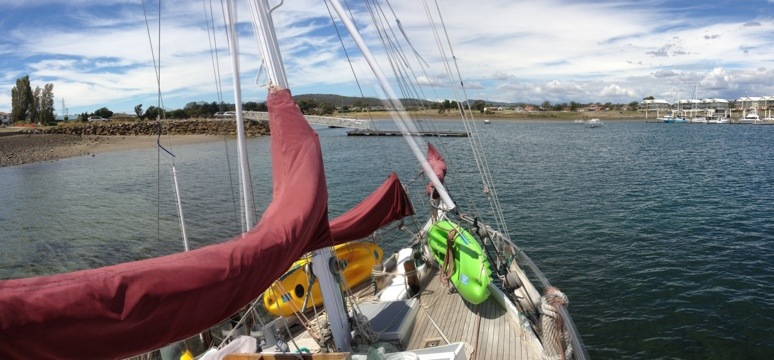
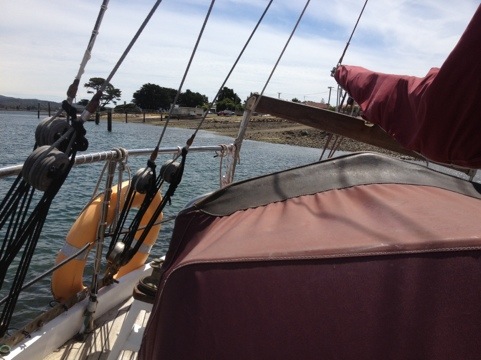
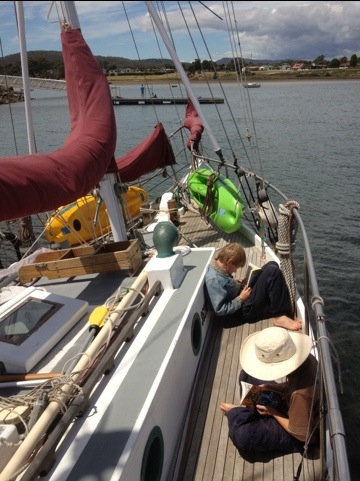
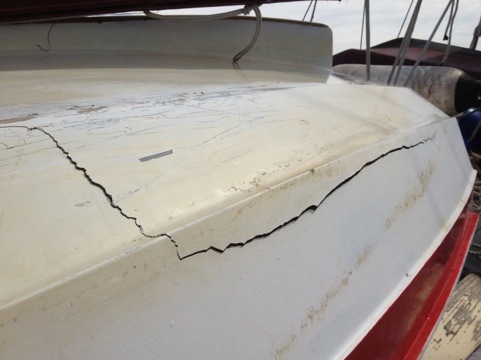
3 Responses to Apparently you aren’t trying hard enough if you don’t run aground